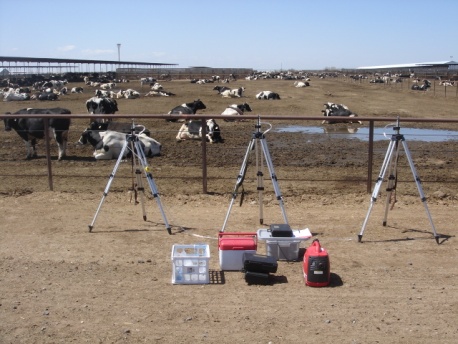![]() Waste to Worth home | More proceedings….
Waste to Worth home | More proceedings….
Abstract
In an effort to assess the off-site transport of bioaerosols, airborne bacteria, fungi, and endotoxin were collected at a 10,000 cow dairy operation. Compared to background locations, the general trend was that bioaerosol concentrations were higher immediately downwind, then decreased with distance from the animal housing. While bioaerosol concentrations did not follow a seasonal trend, they did significantly correlate with meteorological factors such as temperature and solar radiation. Bioaerosol concentrations were also found to be greatest at night, which can be attributed to changes in animal activity and wind speed and reduced exposure of the microorganisms to UV radiation. An analysis of clones generated from air samples collected downwind from the animal housing and pivots spraying dairy wastewater revealed that none of sequence matches were affiliated with bacteria known to be pathogenic to otherwise healthy humans. Results from ongoing research to better understand bioaerosol formation and drift losses during spray irrigation events of dairy wastewater will also be discussed.
 |
|
|
Why Study Bioaerosols at Dairies?
Because confinement of cattle increases the microbioal load at dairy production facilities, there are concerns about on-site and off-site exposures to airborne microorganisms and microbial byproducts. The purpose of this study was to monitor concentrations of airborne bacteria, fungi, and endotoxin at a 10,000 cow open-freestall dairy and fields being irrigated with wastewater to assess their potential to be transported off site. This information is important, as inhalation or ingestion of some bioaerosols can be detrimental to health through infection, allergy, or toxicosis.
 |
|
|
What Did We Do?
Over a one-year period at the dairy, bioaerosols were collected at upwind (background) and downwind sites using glass impingers, direct impaction on media, and a wetted-wall cyclone. Bacteria and fungi were quantified using culture-dependent techniques, while bacteria were also characterized to the genus and species levels by analyzing a region of the 16S ribosomal RNA gene. Airborne endotoxin were captured on filters, then extracted and subsequenetly quantified using the Limulus amebocyte lysate assay.
 |
|
|
What Have We Learned?
Compared to background sites, the general trend was that concentrations of airborne bacteria and endotoxin were higher immediately downwind, then decreased with distance from the animal housing. While bioaerosol concentrations did not follow a seasonal trend, they did significantly correlate with meteorological factors such as temperature, wind speed, and solar radiation. Bacteria and endotoxin concentrations were also found to be greatest at night, which can be attributed to changes in animal activity and wind speed and reduced exposure of the microorganisms to UV radiation. Analysis of cloned 16S rRNA genes generated from air samples collected downwind from the animal housing and pivots spraying dairy wastewater revealed that none of sequences were affiliated with bacteria known to be pathogenic to healthy humans.
Future Plans
Conduct a quantitative microbial risk assessment for zoonotic bacterial pathogens in dairy wastewaters that are land applied using center pivot irrigation systems.
Authors
Robert Dungan, Research Microbiologist, USDA-ARS Northwest Irrigation & Soils Research Laboratory, Kimberly, Idaho, robert.dungan@ars.usda.gov
April Leytem, Soil Chemist, USDA-ARS, Kimberly, Idaho
David Bjorenberg, Agricultural Engineer, USDA-ARS, Kimberly, Idaho
Additional Information
Dungan, R.S. and A.B. Leytem. 2009. Airborne endotoxin concentrations at a large open-lot dairy in southern Idaho. J. Environ. Qual. 38:1919-1923.
Dungan, R.S., A.B. Leytem, and D.L. Bjorneberg. 2010. Year-long assessment of airborne endotoxin at a concentrated dairy operation. Aerobiologia. 26:141-148.
Dungan, R.S., A.B. Leytem, S.A. Verwey, and D.L. Bjorneberg. 2010. Assessment of bioaerosols at a concentrated dairy operation. Aerobiologia. 26:171-184.
Dungan, R.S. and A.B. Leytem. 2011. Ambient endotoxin concentrations and assessment of transport at an open-lot and open-freestall dairy. J. Environ. Qual. 40:462-467.
Dungan, R.S., A.B. Leytem, and D.L. Bjorneberg. 2011. Concentrations of airborne endotoxin and microorganisms at a 10,000 cow open-freestall dairy. J. Anim. Sci. 176:426-434.
Dungan, R.S. 2012. Use of a culture-independent approach to characterize aerosolized bacteria at an open-freestall dairy operation. Environ. Int. 41:8-14.
Acknowledgements
Independent Dairy Environmental Action League (IDEAL)
The authors are solely responsible for the content of these proceedings. The technical information does not necessarily reflect the official position of the sponsoring agencies or institutions represented by planning committee members, and inclusion and distribution herein does not constitute an endorsement of views expressed by the same. Printed materials included herein are not refereed publications. Citations should appear as follows. EXAMPLE: Authors. 2013. Title of presentation. Waste to Worth: Spreading Science and Solutions. Denver, CO. April 1-5, 2013. URL of this page. Accessed on: today’s date.

